Opposing actions of insulin and arsenite converge on PKCdelta to alter keratinocyte proliferative potential and differentiation
- PMID: 20082316
- PMCID: PMC3152260
- DOI: 10.1002/mc.20612
Opposing actions of insulin and arsenite converge on PKCdelta to alter keratinocyte proliferative potential and differentiation
Abstract
When cultured human keratinocytes reach confluence, they undergo a program of changes replicating features of differentiation in vivo, including exit from the proliferative pool, increased cell size, and expression of specialized differentiation marker proteins. Previously, we showed that insulin is required for some of these steps and that arsenite, a human carcinogen in skin and other epithelia, opposes the differentiation process. In present work, we show that insulin signaling, probably through the IGF-I receptor, is required for the increase in cell size accompanying differentiation and that this is opposed by arsenite. We further examine the impact of insulin and arsenite on PKCdelta, a known key regulator of keratinocyte differentiation, and show that insulin increases the amount, tyrosine phosphorylation, and membrane localization of PKCdelta. All these effects are prevented by exposure of cells to arsenite or to inhibitors of downstream effectors of insulin (phosphotidylinositol 3-kinase and mammalian target of rapamycin). Retrovirally mediated expression of activated PKCdelta resulted in increased loss of proliferative potential after confluence and greatly increased formation of cross-linked envelopes, a marker of keratinocyte terminal differentiation. These effects were prevented by removal of insulin, but not by arsenite addition. We further demonstrate a role for src family kinases in regulation of PKCdelta. Finally, inhibiting epidermal growth factor receptor kinase activity diminished the ability of arsenite to prevent cell enlargement and to suppress insulin-dependent PKCdelta amount and tyrosine 311 phosphorylation. Thus suppression of PKCdelta signaling is a critical feature of arsenite action in preventing keratinocyte differentiation and maintaining proliferative capability.
Figures
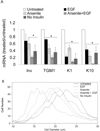

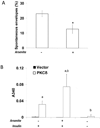
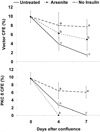
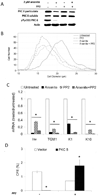
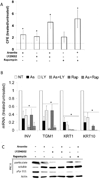
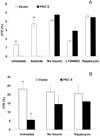
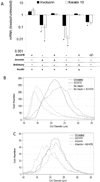
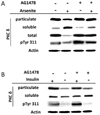
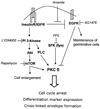
References
-
- Kitchin KT. Recent advances in arsenic carcinogenesis: Modes of action, animal model systems and methylated arsenic metabolites. Toxicol Sci. 2001;172:249–261. - PubMed
-
- Council NR. Arsenic in Drinking Water. Washington: National Academy Press; 2001.
-
- Tseng C-H. Cardiovascular disease in arsenic-exposed subjects living in the arseniasis-hyperendemic areas in Taiwan. Atherosclerosis. 2008;199:12–18. - PubMed
-
- Coronado-González JA, Del Razo LM, García-Vargas G, Sanmiguel-Salazar F, Escobedo-de la Peña J. Inorganic arsenic exposure and type 2 diabetes mellitus in Mexico. Environ Res. 2007;104:383–389. - PubMed
Publication types
MeSH terms
Substances
Grants and funding
LinkOut - more resources
Full Text Sources
Medical
Research Materials
Miscellaneous

